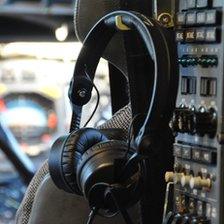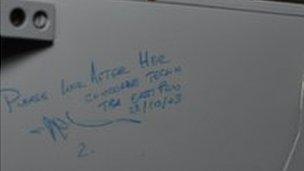How vital is it to get a roof over the Filton Concorde?
- Published

Airbus has spent £1.8m maintaining the Concorde at Filton since 2003
More than 18 months have passed since the Concorde at Filton, near Bristol, was closed to the public.
Alpha Foxtrot, affectionately known as Foxy, was the last of the fleet to fly when the jet was withdrawn from service in 2003, and displaying it at the airfield was only ever a temporary solution.
Concorde enthusiasts are keen to see the aircraft indoors, protected from the elements, and back on display as soon as possible.
But the decision rests with Airbus and British Airways (BA) who are currently considering two separate business plans for museums to house the jet.
So how vital is it to get a roof over the plane?
Ben Lord, chairman of the Save Concorde Group, which submitted its plan for a museum in June 2011, said he was expecting a decision "any day".
The group would like to see Foxy fly again in the future, but Mr Lord said this could only happen if the aircraft was looked after indoors.
"Obviously the long-term thinking is if it's indoors, nice and dry, where engineers can get easier access, ultimately that enhances the prospect of it flying again," he said.
'Harsh winters'
"But the aircraft is still exposed to the elements. Largely it's causing corrosion issues. People could argue that it was outside all the time when it was in service, but when it's flying the outside skin heats up to 127C so it was keeping it dry.
"Being exposed to harsh winters and rainy conditions isn't good for it.
"The shameful part of it all is it will be nine years in November. By now it should be under cover."
The Concorde Trust has been working on plans for an indoor museum for some years, but hit a snag in May last year when their bid for £2.9m from the Heritage lottery Fund was turned down.

The first UK-built Concorde took off from Filton Airfield
The trust has since submitted revised plans.
Project director Lloyd Burnell said the trust was working with the Bristol Aero Collection (BAC) on plans for a museum.
"It needs to be undercover for the preservation of the aircraft. Aircraft are not designed to sit around," he said.
Another reason they want it indoors is so the museum can also display the BAC - exhibits charting 100 years of the city's aviation history.
"We submitted plans to the Heritage Lottery Fund last year. That total scheme was £9m and the application was for £2.9m. They were turned down. We continued to work on alternative proposals with a number of major stakeholders," Mr Burnell said.
"The Concorde Trust and BAC work as a single organisation as Concorde is part of the Bristol aviation heritage collection - arguably the most well-known, the centrepiece of the collection - and it all needs to stay together."
But Mr Burnell was tight-lipped about what their plans involved.
"It's very easy to over-promise which leads to levels of expectation. We are not going to do that," he said.
Nose ripped off
Of the fleet being kept in the UK, Foxy is not the only Concorde being kept outside. One is on display alongside a runway at Heathrow Airport, while another is outside at Brooklands Museum in Weybridge.
Conditions also vary with those being displayed abroad.
Mr Lord said the Concorde on display indoors near Paris was in "fantastic condition".
"All of its systems have been kept going long since it was delivered to the museum nine years ago," he said.

The message 'please look after her' has been left inside the plane
But he added: "I have seen Alpha Delta in New York and she's been through the wars."
The Concorde, which was being kept outdoors while a museum was constructed, had its nose ripped off in 2008.
Since Foxy's last flight in 2003, Airbus has spent £1.8m on maintaining the aircraft.
A spokesman for Airbus said: "A lot of the guys involved in the maintenance were involved in the actual building of it so it's a labour of love. They're incredibly affectionate about it.
"It needs to be undercover, everyone agrees. Everyone hopes we can have a permanent home here at Filton."
He said Airbus and British Airways (the aircraft's owner) were currently evaluating the proposals and hoped to be in a position to announce a way forward "in the near future".
"Although in a good condition, Concorde 216 has been parked outside at Filton airfield since 2003 and is clearly in need of a permanent home undercover," he said.
"Airbus have run an in-depth maintenance programme which will help secure the long term preservation of the aircraft.
"To date weather proofing, re-protection, skin panel repairs and corrosion removal work has been successfully carried out. Weekly inspections of the airframe are carried out by a skilled maintenance team."
'Home of Concorde'
A BA spokesman said: "We've got one in the open air at our engineering base at London Heathrow, it's been there since it landed.
"Planes are designed to survive out of doors, but they have to be maintained or they will rust. They don't need the electrics maintained because they're just an empty shell but they have to be kept clean.
"It's preferable that they're kept indoors, but not vital."
The groups bidding to build a museum say having one near Bristol is of particular significance because Filton is where the first UK-built Concorde took off from.
"Filton is the home of Concorde," Mr Burnell said.
"Concorde is written quite deep into the hearts and minds of people, particularly in this area in this region. More broadly it is a symbol of UK innovation, technological achievement and ambition.
"It's a very important symbol and should be preserved. As much as anything else, if you've seen Concorde it's an inspiring aircraft that still really excites people.
"The way we see Concorde being used is a means of engaging and inspiring young people to get them into science and technology and innovation.
"That's probably the most important thing for us."
Mr Lord said: "It's absolutely critical it's undercover.
"Even if we get the go-ahead it could be six to nine months before we get planning permission. That's another winter she's exposed.
"Whatever happens, whether we are successful or the Concorde Trust, she will still be outside for another year or so."
- Published28 February 2012
- Published21 September 2011
- Published9 June 2011
- Published1 June 2011
- Published30 May 2011
- Published20 May 2011
- Published15 April 2011
- Published24 November 2010
- Published15 July 2010